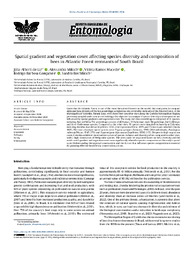Spatial gradient and vegetation cover affecting species diversity and composition of bees in Atlantic Forest remnants of South Brazil.
Spatial gradient and vegetation cover affecting species diversity and composition of bees in Atlantic Forest remnants of South Brazil.
Author(s): LIZ, J. A. de; MIKICH, A.; MACEDO, V. R.; GONÇALVES, R. B.; MIKICH, S. B.
Summary: Given that the Atlantic Forest is one of the most threatened biomes in the world, this study aims to compare alpha and beta diversity of the bee assemblage sampled in a site covered by remnants of the Atlantic Forest, in the municipality of Colombo, Paraná State, with those from ten other sites along the Curitiba Metropolitan Region, previously sampled under similar methodology. Our objective is to analyze if species diversity and composition are influenced by spatial gradients and vegetation cover. The study site’s bee assemblage is composed of 91 species, including Apis mellifera. The assemblage consists of 42 Apinae, 33 Halictinae, eight Megachilinae, five Colletinae, and three Andreninae species. Compared to the other sites, 11 species were sampled exclusively in Colombo, including Bombus brasiliensis Lepeletier, 1836, Centris proxima Friese, 1899, and Trichocerapis mirabilis (Smith, 1865). The most abundant native species were Trigona spinipes (Fabricius, 1793) (204 individuals), Paratrigona subnuda Moure, 1947 (176) and Scaptotrigona bipunctata (Lepeletier, 1836) (113). Despite its high vegetation cover, Colombo exhibited intermediate values of species richness and diversity when compared to other sites, with a high dominance of Meliponini species. The sites could be separated based on beta diversity and the north–south gradient and vegetation cover were significantly related to species composition at this study’s spatial scale. Understanding the regional communities and the factors that influence species composition is essential for planning effective biodiversity conservation actions.
Publication year: 2024
Types of publication: Journal article
Unit: Embrapa Forestry
Keywords: Abelha, Apis Mellifera, Araucaria Forest, Biodiversidade, Biodiversity, Bombus brasiliensis, Centris proxima, Grasslands, Inseto Polinizador, Levantamento, Paratrigona subnuda, Pastagem, Pollinators, Scaptotrigona bipunctata, Surveys, Trichocerapis mirabilis, Trigona Spinipes, Urbanization, Urbanização
Observation
Some of Embrapa's publications are published as ePub files. To read them, use or download one of the following free software options to your computer or mobile device. Android: Google Play Books; IOS: iBooks; Windows and Linux: Calibre.
Access other publications
Access the Agricultural Research Database (BDPA) to consult Embrapa's full library collection and records.
Visit Embrapa Bookstore to purchase books and other publications sold by Embrapa.

